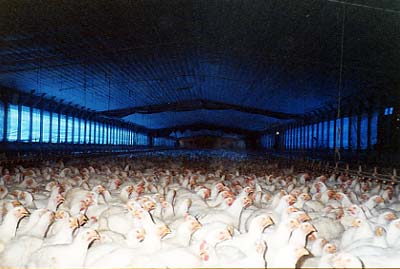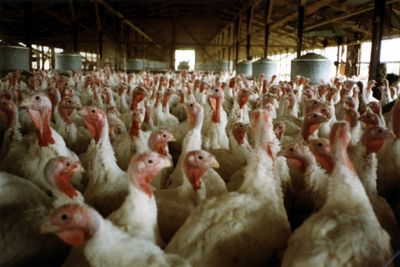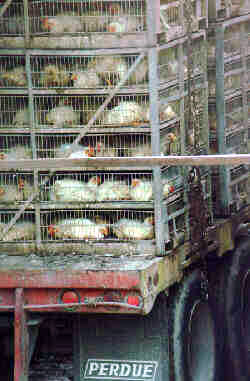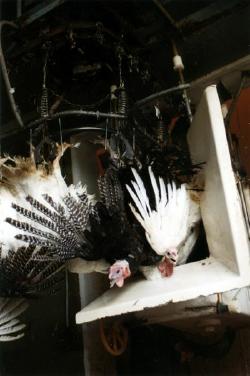CHICKENS & TURKEYS

As more consumers switch from red meat to poultry, the chicken & turkey
industries are expanding at a tremendous rate in both the U.S. market &
around the world.
Each year ten billion chickens & half a billion turkeys are hatched in the
U.S. In factory-like warehouses each chicken is given less than half a
square foot of space, while turkeys are each given less than three square
feet.

Soon after hatching, both chickens & turkeys have the ends of their
beaks cut off. Turkeys also have the ends of one or two of their toes clipped off. These painful
mutilations are performed to avoid the injuries that would occur from
fighting caused from stress that the birds will experience every day.
Broiler chickens are altered genetically to grow twice as fast & twice as
large as they would normally. Hundreds of millions of chickens are
slaughtered at 6 weeks of age. They often experience crippling leg
disorders, & heart failure due to under developed heart & lungs,
resulting from their accelerated growth. They live their short lives
confined in unsanitary factory farms, often among birds dieing of infectious
diseases.
Turkeys are also genetically manipulated to have extremely large breasts to
meet consumer demand for breast meat. Factory-farmed turkeys are prone to
heart disease & leg injuries resulting from their extremely overweight
bodies.
Turkeys have been bred to grow faster & heavier but their skeletons
haven't kept pace, which causes 'cowboy legs'. Commonly, the turkeys have
problems standing & fall & are trampled on or seek refuge under feeders,
leading to bruises & downgradings as well as culled or killed birds.

Chickens & turkeys are taken to the slaughterhouse in crates stacked on
the backs of open trucks.

Upon arrival at the slaughterhouse, the birds are
either pulled individually from their crates, or the crates are lifted off
the truck, often with a crane or forklift, & the birds are dumped onto a
conveyor belt. As the birds are unloaded, some miss the conveyor belt &
fall onto the ground. Slaughterhouse workers intent upon 'processing'
thousands of birds every hour have neither the time nor the inclination to
pick up individuals who fall through the cracks, & these birds suffer grim
deaths. Some die after being crushed by machinery or vehicles operating near
the unloading area, while others may die of starvation or exposure days, or
even weeks, later.

Once inside the slautherhouse, fully conscious birds are hung by their feet
from metal shackles on a moving rail. The Federal Humane Slaughter Act
requires that animals be stunned before being slaughtered. Chickens are
excluded from being protected by this act. The killing is expedited by
first stunning the birds in an electrified water bath to immobilize them.
During this stunning processes the electrical current is often lower than
what is required to render the birds unconscious in an effort to minimize
damage to the carcasses. While these birds are immobilized after stunning,
many are still conscious & capable of feeling pain.
From the stunning tank, the birds' throats are slashed, usually by a
mechanical blade. The blade sometimes misses some birds, who may be
struggling after inadequate stunning. The scalding tank is next where the
birds are submerged in boiling hot water. By the millions each year, birds
not killed by the blade are boiled alive.

